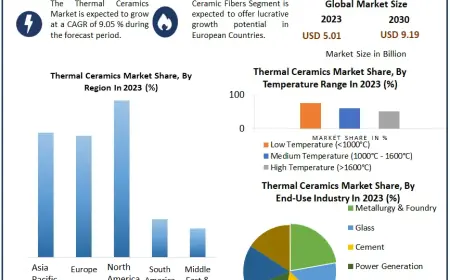India Solar Rooftop Market Analysis and Future Growth Projections 2024 - 2032
The India solar rooftop market is experiencing a rapid transformation, driven by the country’s growing demand for clean and renewable energy. As the world’s third-largest emitter of greenhouse gases, India is increasingly recognizing the importance of harnessing solar power to reduce its carbon footprint and meet energy demands. The solar rooftop market in India is a significant part of this transition, offering a decentralized and cost-effective energy solution for residential, commercial, and industrial sectors alike. With favorable government policies, falling costs of solar panels, and rising environmental awareness, the growth prospects for India’s solar rooftop market have never been brighter.
Growth Drivers of the India Solar Rooftop Market
The India solar rooftop market is benefiting from several key factors that are driving its expansion:
1. Government Support and Policies
India’s government has rolled out various incentives and schemes to promote the adoption of solar rooftop systems. The National Solar Mission is one of the flagship programs aimed at boosting solar power generation in the country. The government provides subsidies, tax benefits, and low-interest loans for solar rooftop installations, which have significantly lowered the upfront costs for consumers. In addition, the Solar Rooftop Subsidy Scheme introduced by the Ministry of New and Renewable Energy (MNRE) is playing a pivotal role in making solar energy more accessible to residential users.
2. Cost Reductions in Solar Technology
The cost of solar panels and other necessary components has significantly decreased over the past decade. Technological advancements, increased production capacity, and competition among suppliers have made solar power increasingly affordable. This trend has encouraged a wider adoption of solar rooftop solutions by residential, commercial, and industrial users who seek to reduce electricity bills while promoting sustainability.
3. Rising Electricity Prices
With the increasing cost of conventional grid electricity, many consumers are looking for alternatives to reduce their energy expenses. Solar rooftop systems provide an attractive solution by allowing users to generate their own electricity, thereby reducing their dependence on the grid. This self-sufficiency has become especially appealing to businesses and homeowners, who can save a substantial amount on electricity bills in the long term.
Solar Rooftop Market Segmentation
The India solar rooftop market can be segmented based on installation type, end-user application, and region. Let’s explore these segments in greater detail.
1. Based on Installation Type
-
On-Grid Solar Rooftop Systems: These systems are connected to the local grid and allow users to feed excess power back into the grid in exchange for credits or payments, depending on the regulations of the region. On-grid systems are widely popular due to their affordability and efficient energy usage.
-
Off-Grid Solar Rooftop Systems: Off-grid systems are independent of the main electricity grid and typically use batteries to store excess power for use during the night or during periods of low sunlight. These systems are more expensive due to the cost of batteries but are ideal for remote areas with unreliable grid access.
-
Hybrid Solar Rooftop Systems: These combine the benefits of both on-grid and off-grid systems, offering more flexibility and reliability by using batteries for storage and a grid connection for backup. Hybrid systems are gaining popularity, especially in urban areas with intermittent power supply.
2. By End-User Application
-
Residential Sector: With increasing awareness about renewable energy, more and more households in India are opting for solar rooftop installations to cut down on electricity costs and contribute to environmental conservation. Residential users are primarily adopting on-grid solar solutions for ease of use and minimal upfront investment.
-
Commercial Sector: The commercial sector, including office buildings, retail chains, and educational institutions, is also investing heavily in solar rooftop systems. Businesses are keen to reduce their operational costs and improve sustainability, and solar rooftops offer a viable solution to meet both goals.
-
Industrial Sector: Large-scale industries are particularly interested in solar rooftop installations as they offer significant savings on energy bills. With high electricity consumption, industries can benefit from both economic and environmental advantages by adopting solar power on a large scale.
3. Regional Segmentation
The solar rooftop market in India varies significantly across regions, with some states being more proactive in adopting solar power.
-
Rajasthan, Gujarat, and Maharashtra: These states have abundant sunlight and a high concentration of industrial and commercial users. They are leading the adoption of solar rooftops.
-
Karnataka and Tamil Nadu: These states have also seen substantial growth in the solar rooftop segment, particularly in the residential sector, thanks to their favorable policies and attractive incentives.
-
Delhi and Uttar Pradesh: In urban centers like Delhi and Uttar Pradesh, demand for solar rooftops is growing rapidly due to government mandates, awareness campaigns, and rising electricity prices.
Challenges Facing the India Solar Rooftop Market
While the India solar rooftop market holds immense potential, several challenges remain:
1. High Initial Investment
Despite significant cost reductions in recent years, the initial investment for solar rooftop systems can still be prohibitively high for many consumers. While financing options are available, the need for greater financial incentives and support mechanisms remains crucial to promote widespread adoption.
2. Grid Connectivity and Technical Issues
For on-grid systems, a stable and reliable connection to the national electricity grid is essential. In some rural and semi-urban areas, the grid infrastructure may not be robust enough to support large-scale solar installations, leading to technical issues and delays in system installations.
3. Awareness and Education
Although awareness of solar energy is growing, many consumers still lack adequate knowledge of the financial and environmental benefits of solar rooftops. Education campaigns and community engagement are necessary to encourage adoption across all sectors.
4. Regulatory Hurdles
While the Indian government has made significant strides in promoting solar energy, regulatory barriers, such as complicated approval processes and lengthy documentation, still present challenges to solar rooftop implementation.
Future Outlook for the India Solar Rooftop Market
The India solar rooftop market is poised for continued growth as the country progresses towards its renewable energy targets. The government’s continued support through incentives and policy frameworks, along with the increasing affordability of solar technology, will drive further adoption. Additionally, the growing concerns over climate change and energy security are likely to increase demand for clean energy solutions. By 2030, India aims to achieve 500 GW of renewable energy capacity, with solar rooftop systems playing a central role in meeting this ambitious goal.
Key Takeaways
-
India’s solar rooftop market is growing rapidly, fueled by government initiatives, cost reductions, and rising electricity prices.
-
The market is segmented into residential, commercial, and industrial applications, each with distinct needs and growth potential.
-
Although there are challenges, such as high upfront costs and grid connectivity issues, the long-term prospects remain positive.
-
The future of the India solar rooftop market looks promising, with continued growth expected as part of the country’s broader renewable energy strategy.
In conclusion, the India solar rooftop market is an exciting and rapidly expanding sector that offers numerous opportunities for investors, consumers, and businesses. As India continues to prioritize sustainable energy solutions, solar rooftops will play an increasingly central role in the country’s energy future.
More Trending Reports
Direct Methanol Fuel Cell Market Analysis
Hydraulic Components Market Analysis
What's Your Reaction?
 Like
0
Like
0
 Dislike
0
Dislike
0
 Love
0
Love
0
 Funny
0
Funny
0
 Angry
0
Angry
0
 Sad
0
Sad
0
 Wow
0
Wow
0













































